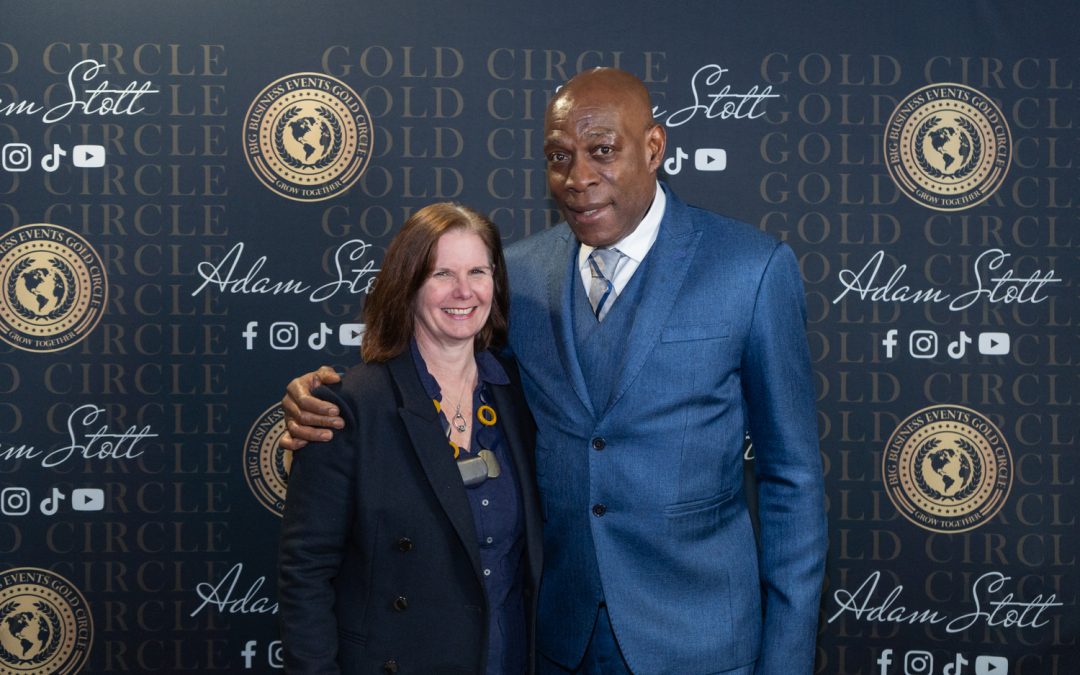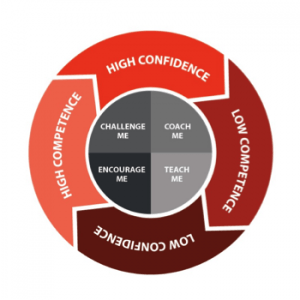
by Julia Felton | Feb 7, 2025
Few people have the opportunity to meet a true sporting legend, but recently, I had the privilege of meeting Frank Bruno, the former world heavyweight boxing champion. Meeting him invoked childhood memories as my dad always used to impersonate him and his banter with legendary sporting commentator Harry Carpenter, as he was infamous for always saying “Know what I mean, Harry?”
Listening to his stories and reflecting on his journey, I realised there were profound lessons in his resilience, discipline, and mental strength. Frank’s life, both in and outside the ring, offers valuable insights for business leaders, teams, and anyone striving to overcome challenges and achieve greatness.
Here are three key lessons I took away from my encounter with Frank Bruno.
1. Resilience: Bouncing Back from Setbacks
Frank Bruno’s boxing career was filled with both triumphs and setbacks. He fought some of the greatest heavyweights of his era, including Mike Tyson and Lennox Lewis. Despite crushing defeats, he never abandoned his dream of becoming a world champion. In 1995, after multiple attempts, he finally won the WBC heavyweight title, proving that persistence and resilience pay off.
In business and leadership, setbacks are inevitable. The key is how we respond to them. Many teams and leaders get discouraged when things don’t go as planned, but resilience means learning from failures, adapting strategies, and coming back stronger.
Key takeaway: Don’t let setbacks define you. Instead, let them refine you. Just as Frank Bruno kept stepping back into the ring despite losses, business leaders must embrace challenges, pivot when necessary, and keep moving forward toward their goals.
2. Discipline and Hard Work: The Foundation of Success
Boxing isn’t just about physical strength; it demands immense discipline and dedication. Frank Bruno was known for his rigorous training regime and unwavering commitment to his craft. He understood that success in the ring wasn’t achieved overnight—it was built through years of sacrifice, discipline, and relentless effort.
In leadership and teamwork, the same principles apply. Success doesn’t happen by chance. It results from consistent effort, strategic planning, and disciplined execution. Whether developing a high-performing team or executing a business strategy, discipline forms the foundation that turns aspirations into reality.
Key takeaway: Success is built on daily habits and small, consistent efforts. Whether you’re leading a team or running a business, discipline and hard work will always be your best allies in achieving long-term success.
3. Mental Toughness: Strength in Adversity
Frank Bruno’s battles weren’t just in the boxing ring. He has openly shared his struggles with mental health, showing incredible courage in discussing a topic often stigmatised, especially in sports. His openness and determination to overcome personal challenges are as inspiring as his victories in the ring.
Leaders and business owners face intense pressure, uncertainty, and moments of self-doubt. The ability to remain mentally strong, even in adversity, separates great leaders from the rest. Mental toughness doesn’t mean ignoring emotions or pretending problems don’t exist. It means developing the inner strength to navigate difficulties with clarity, confidence, and resilience.
Key takeaway: Mental health and emotional resilience are just as important as physical strength. Prioritise self-care, seek support when needed, and cultivate a mindset that enables you to navigate challenges with courage and perseverance.
Final Thoughts
Meeting Frank Bruno was an unforgettable experience that reinforced the importance of resilience, discipline, and mental toughness. Whether in sports, business, or life, these qualities are essential for overcoming obstacles and achieving greatness.
As business leaders, we may not be stepping into a boxing ring, but we face our own battles daily. By embracing the lessons from Frank’s journey—staying resilient in setbacks, committing to discipline and hard work, and strengthening our mental resilience—we can achieve extraordinary success in our own arenas.
So, the next time you face a tough challenge, ask yourself: What would a champion do? Then, step forward with the mindset of a true fighter.

by Julia Felton | Oct 15, 2024
Box breathing is a powerful, yet simple, relaxation technique that aims to return breathing to its normal rhythm. This breathing exercise may help to clear the mind, relax the body, and improve focus.
The technique is also known as “resetting your breath” or four-square breathing. It is easy to do, quick to learn, and can be a highly effective technique for people in stressful situations.
Typically used by people with high-stress jobs, such as soldiers and police officers, and now used much more widely by everyone on a daily basis, box breathing is used when the body is in fight-or-flight mode. This technique is also works for anyone interested in re-centering themselves or improving their concentration, so they can become more present and aware.
So How Do You Box Breathe?
There are four simple steps required to master box breathing. It is a simple technique that you can do anywhere, including at a work desk or in a cafe. Before starting, you should sit with their back supported in a comfortable chair and their feet on the floor.
- Close your eyes. Breathe in through your nose while counting to four slowly. Feel the air enter your lungs.
- Hold your breath inside while counting slowly to four. Try not to clamp your mouth or nose shut. Simply avoid inhaling or exhaling for 4 seconds.
- Begin to slowly exhale for 4 seconds.
- Repeat steps 1 to 3 at least three times. Ideally, repeat the three steps for 4 minutes, or until calm returns.
If you find the technique challenging to begin with, they can try counting to three instead of four. Once you are used to the technique, you may choose to count to five or six
Why Breathe Is Vital To Health
Resetting your breath, or working to make the breath leave fight-or-flight mode, is good for both the mind and body.
The unconscious body, or the autonomic nervous system, refers to the functions that take place without any thought, such as the heart beating or the stomach digesting food. This system can be in a fight-or-flight or rest-and-digest state.
In fight-or-flight mode, the body feels threatened and reacts to help the person escape or avoid a threatening situation. Among other things, the body releases hormones to make the heart beat faster, breathing to quicken, and to boost blood sugar levels.
Having this state of stress activated too often, or for too long, has adverse consequences on health, however. The physical impact of this state can cause wear and tear on every system in the body.
Long-term stress can increase the risk of conditions that include:
The ability to consciously regulate breath allows the body to leave a state of stress and enter into a state of calm and awareness.

by Julia Felton | Feb 14, 2024
The recent England v Wales rugby game as part of the 2024 Six Nations Championship was a masterpiece in how The GC Index can be used to assess and develop high-performance teams.
England, with their Game Changer energy, set the tone early on with bold and inventive plays that kept Wales on the back foot. Their strategic approach, led by the Strategist energy, allowed them to anticipate Wales’ moves and exploit openings with precision.
Wales, however, demonstrated their resilience and adaptability, embodying the Play Maker archetype by orchestrating intricate manoeuvres, using the right players at the right moments to capitalise on fleeting opportunities. With their ability to read the game and make split-second decisions, Wales remained a formidable adversary throughout.
As the match progressed, both teams relied on their Polisher qualities to refine their execution and maintain momentum. England’s attention to detail and flawless execution bolstered their lead, while Wales’ commitment to perfecting their tactics kept them within striking distance.
In the crucial moments of the game, it was the Implementer energy that proved decisive. England’s disciplined approach and methodical game management secured them a hard-fought victory, as they meticulously executed their game plan to overcome Wales’ determined resistance.
In the end, England emerged triumphant in a closely contested encounter, showcasing the power of understanding and leveraging The GC Index proclivities to achieve success on the rugby field.
Reach out to me if you want to understand how you can use the GC Index to change the way you think about teams, performance, strategy and impact.
At Business HorsePower we use the GC Index with teams, individuals and organisations looking to maximise their impact and success.
Thanks to my mentor and The GC Index founder, Nathan Ott for the inspiration behind this.
#thegcindex #teamperformance #rugby #sixnations

by Julia Felton | Aug 4, 2020
Business stakeholders—customers, investors, and team members—are now demanding more from the businesses they “work” with. Millennials and Gen Z want to know that the businesses they engage with have a social purpose and are behaving in a responsible manner. This societal accountability is changing the face of business and how leaders behave.
A number of recent surveys from McKinsey research have identified three traits that are becoming leadership imperatives to respond to this growing demand for social accountability.
Transparency
As consumers are more and more demanding that they see the provenance of items they purchase to ensure they align with their values, leaders are being forced to rethink their supply chain and the materials that they use. Especially as some two-thirds of consumers around the world say they would switch, avoid, or boycott brands for their stances on controversial issues.
Given that millennials will make up 75% of the buying population by 2025, and 52% of them say that they always research background information before buying goods or services—compared with 45% of Generation X consumers and 41% of baby boomers—the onus on leaders to pay attention to the ripple effect their business is creating is significant.
One way some companies are seeking to be more transparent is by adopting B-corp status. In order to become a B-corp, a company must pass an assessment that measures its impact on its employees, customers, community, and environment. Ben & Jerry’s and Patagonia are two such companies that have shifted to becoming B-corps in a bid to be more transparent and socially responsible in how they operate.
Cognitive Empathy
In 2015, the World Economic Forum predicted that emotional intelligence would be one of the top 10 skills demanded by employers by 2020. Emotional intelligence (EI) relates to qualities such as empathy and curiosity, the so-called traditional business soft skills that enable effective communication and relationship building.
However, it turns out that there is more than one type of empathy. Emotional empathy involves:
- feeling the same emotion as the other person
- feeling our own distress in response to their pain
- feeling compassion toward the other person
This is distinct from cognitive empathy, which seeks to recognise and understand another person’s emotional state. When leaders practice cognitive empathy, they practice taking the perspective of another person. In essence, you imagine what it might be like to actually be this person in their situation and put yourselves in their shoes.
For leaders to be socially accountable, it is essential that they practice this type of empathy, as it enables them to fully understand and appreciate the perspective of all their stakeholders so they are able to make better decisions, as they consider the holistic impact of what they are doing.
Purpose and Values Driven
Consumers are also demanding that business recognizes the impact it has on society and that it aligns the 3P’s—purpose, profit, and planet. No longer is it acceptable for CEO’s to focus on short-term gain to line their pockets. Rather, business leaders need to take a longer term approach, which means no longer being driven by the 90-day reporting cycles of the world’s stock markets.
In his new book The Infinite Game, Simon Sinek refers to these leaders as being infinite in their approach, as they understand that long-lasting success only occurs if they build long-term value for customers, which translates into healthy enduring for the business.
Salesforce CEO Marc Benioff is an example of an “infinite leader” who understands the importance of social accountability, as he always strives to ensure that the company lives up to its values of trust, innovation, equality, and customer service. “There will be times when prioritizing values, especially trust, will come at the expense of profits. In the short term, that is,” he is quoted as saying. “But the money your company makes in any given quarter will never be more valuable than the trust you stand to lose over time.”
What do you need to do to shape your leadership, so that it meets the needs of all stakeholders and recognises the social accountability that consumers now demand of business?

by Julia Felton | May 26, 2020
I don’t think anyone can dispute that now, more than ever, we need great leaders. People who can step up and show others the way. People who take charge, not in an overbearing way, but in a way that inspires others to follow. After all, you can’t be a leader unless others will follow you.
Leaders emerge in all shapes and sizes and from all ranks of the organization and society. Leadership is not something just reserved for the top bastion of an organization. It exists everywhere, and right now we are witnessing some great leadership and also some really poor leadership. I’ll leave you to decide which is which!
To help leaders navigate this situation, I have identified 7 characteristics they need to embody to be successful. These form the acronym LEADERS.
Leaderself
Great leaders understand that they need to look after themselves first, before they can look after others. It’s a classic case of putting your oxygen mask on first before helping others. For many leaders, this means indulging in self-care—which could include meditation, exercise, and eating and sleeping well. There is no one solution that fits everyone, but prioritizing your own well-being is paramount if you are to have the energy to inspire and motivate others.
Engaging
Leaders understand that they need to engage others. This is particularly true when so many team members are working remotely. Leaders need to spend time with these remote workers really understanding their needs and effectively communicating what is happening. During these times you can’t over-communicate—team members, customers and other stakeholders will only feel engaged if they know what is happening. And even if you don’t know what is happening, share that as well!
Adaptable
Being adaptable is a key attribute of a great leader. They are easily able to see the whole picture, recognize opportunities, and then pivot their resources to solve the challenge they have identified. There are plenty of examples of companies adapting to this change. For example, Brew Dog in the UK has pivoted to creating hand sanitizers rather than making beer.
Decisive
Great leaders are decisive. They make the difficult decisions that others won’t. Here in the UK, I think our Prime Minister, Boris Johnson, made some good decisions early on putting us into lockdown. Was it popular? No, it wasn’t—but undoubtedly his actions have saved many lives.
Empathy
A component of emotional intelligence, empathy is the ability to put yourself in someone else’s shoes. Great leaders understand that how they view the situation might be very different from their team members, and indeed everyone is experiencing this situation differently. Taking the time to really connect with team members and understand their concerns is paramount to being seen as a caring leader at this time.
Resilience
Mental toughness is a requirement for leaders at all times, but none more so than now. Being able to bounce back from adversity is imperative, as is being able to maintain a great state of mind. Being positive and encouraging inspires your team to want to follow up. Resilience enables leaders to stay focused and on track, despite everything else that is happening around them.
Solution Focused
One of the great things to come out of this pandemic is the high level of innovation that we have seen. Companies have changed their work routines literally overnight, as team members have had to start working from home. Other businesses—like Brew Dog—have redirected resources to help provide much needed hand sanitizer, whilst some car producers have pivoted to create ventilators. Restaurants have moved into the takeaway market. Product development has been speeded up. For example, James Dyson designed a ventilator in a matter of days rather than months.
No one doubts that this pandemic will totally transform the way that we operate business going forward, and I firmly believe that the leaders that display great leadership at this time are the ones that will enable their companies to survive in the long term. Team members and other stakeholders will remember how they have been treated, and I firmly expect them to vote with their feet, leaving companies where they have not been supported and cared for during these challenging times.

by Julia Felton | Apr 26, 2020
The COVID-19 pandemic has turned many businesses on their heads overnight, as people have had to adjust to remote working. Many industries that had been resisting allowing team members to work at home have, in a matter of a few days, had to pivot and adapt to this new norm.
For both team members and employers, there have been challenges to navigate along the way. Not least of all is that employers have had to trust that team members will do the work. For some companies that had resisted remote working up to this point, I know they had an inherent distrust in their team members and didn’t believe that the employees would do a full day’s work. Ironically, I often hear of exactly the opposite happening. Stuck at home with their families, some people are gravitating to work as a means of escape and so are working way more than the standard working week hours. I know my brother is one such person. It’s so easy to go back into this office after his kids have gone to bed and just check email again or finalise that report he was writing.
So, how do we find a happy medium—and how do all parties communicate effectively at this time? I’d like to propose the 5 E Framework as a model for helping navigate this change:
Embed The Purpose
Now, hopefully your organisation has a clear purpose that every team member understands. Purpose provides the raison d’etre for the business and, combined with company values, helps everyone have clarity on where the business is going. It provides the true north of what is expected and therefore can guide team members in how to prioritise their work and decision making, when there are no colleagues directly around.
Clear Expectations
When working remotely, it is essential that everyone is clear on what is expected of them. Know what the protocol is for answering emails and responding to messages, what the work hours are, etc. Many people I know feel that they have to respond immediately to every notification that pings on their computer, or else their boss won’t think they are working. This is foolhardy, as all these notifications distract us and, in fact, hamper our productivity. Remember the technology should be there to support you, not negatively disturb you.
Empower Team Members
When working remotely, it is even more important than ever to stop micro-managing your team members and empower them to get the job done. Give them a clear briefing; make sure they have understood the briefing, the deliverables, and the timeline; and then, let them get on with it. Continually checking in to see how they are getting on with the project will just demotivate and frustrate them.
Engage and Connect
In the absence of “water-cooler” chat and seeing colleagues face-to-face, it is important to check in with them and make sure they are okay. Everyone is reacting differently to these challenging situations—so, as a leader, spending time to really connect and find out what is going on for your team members, outside of work, is essential. It helps builds trust and connection, and demonstrates empathy.
Efficient Communication
Ensure that you communicate regularly with your team members when they are working remotely. In this time of rapid change, that might mean a daily check-in call for the team to make sure everyone is on the same page and has all the information they need. It’s amazing how much information you glean when working in an office, and how often people forget to communicate really important things when they don’t see the other person face-to-face. I was recently coaching a client, and her boss had forgotten to tell her the deadline had changed. It wasn’t malicious—it was just an oversight. So, regularly ensuring everyone is on the same page can mitigate this.
Effective virtual communication also means that you need to use the appropriate level of energy. As a leader, it is your job to inspire the team, and your energy and enthusiasm needs to be contagious at this time, in order to keep your virtual team motivated.
I’d love to hear about the lessons you’ve learnt about effective virtual communication at this time!

by Julia Felton | Mar 26, 2020
Many of you might have recently read or seen extracts from Simon Sinek’s new book on the Infinite Game. In it, he suggests that business leaders should stop focusing on short-term (finite) gains and instead focus on the long-term (infinite) game of the business. This is something I wholeheartedly agree with—but it’s nothing new as a concept.
When at school, I clearly remember learning about Japanese theory management and how, in Japan, people were more concerned with the long-term outcomes of what they did rather than the immediate short-term benefits. The challenge for leaders in the West today has become the fixation on short-term results. Public companies are measured by their 90 day success on the stock market. If the CEO fails to make the numbers, the stock price plummets. The result is that business leaders make decisions based on short-term success, rather than considering the longer-term consequences.
When leaders are always seeking to win the game, rather than acknowledge and appreciate that their decisions today have a ripple effect throughout society, the quality of their decision making can be significantly impaired.
That is why it was so heartening to see Paul Polman, former CEO of Unilever, stop publishing quarterly results back in 2010 and informing shareholders that “if they didn’t buy into this long-term value-creation model, which is equitable, which is shared, which is sustainable, then don’t put your money in our company.” Curiously, over the decade that Polman was at the helm, Unilever’s shareholder return has significantly outperformed the FTSE index. What Polman clearly understood was that if you are kind to the planet and the communities in which you operate, that long-term success is inevitable.
So, what exactly are the differences between a finite and infinite approach to business and life? In his book Finite and Infinite Games, the author James Carse identifies the difference as being:
- Finite games have a start and finish. They are played within a boundary. There are rules that shape the play on the field, and whoever is the most powerful at the end of the game wins.
In contrast:
- Infinite games are ongoing. There is no start and no finish. Once you enter an infinite game, the critical asset is endurance and resilience.
What can we learn from nature about having an infinite mindset?
Nature is always playing an infinite game—after all, it has been around for 3.8 billion years. In nature, if you don’t play the game and adapt, you die. Which is why we see so many species that have endured over time simply by adapting to the changing environments in which they find themselves. Contrast this with the abject failure of household brands such as Nokia, BlockBuster, and Kodak—all companies that failed to realise they were playing a long-term game, and so steadfastly resolved not to change and innovate as the environment and changing landscape shifted.
For leaders, really understanding that work is infinite can massively change your perspective on things. Just imagine, if you really appreciated that business was an infinite game, you would stop saying things like: “If I just stay late I’ll get caught up” (we all know that never happens!) or “If I just sacrifice seeing my kid’s event this evening, I’ll be in a better position for work tomorrow.” When we focus on work and business being an infinite game, we realise that it will never stop, there will always be something to do, a pivot to make, a promotion to plan.
The work will never stop—however, as leaders, what we can control is how we respond to this.
When leaders recognise that work is continually evolving (just like nature) and their job is just to harness and direct it in order to get the best overall outcome, it brings a degree of flexibility and freedom to the role. With an infinite mindset, leaders can build stronger, more innovative, more inspiring organisations that are committed to bringing meaning and contribution to their lives.
One of the first steps in creating an infinite business is to create a compelling purpose and vision, something that will make a real difference in the world and which will drive you forward on a daily basis.

by Julia Felton | Feb 17, 2020
“We need to get rid of rules – real and imagined – and encourage independent thinking.”
–Howard Behar, Starbucks
Great leaders recognize that business success is a team sport and they cannot do it all for themselves. That is why the old paradigm of command and control structures will no longer be a successful leadership model.
There is an unprecedented need to effectively delegate to get everything done; however, there is a spectrum to delegation. At one end of the spectrum are task-based activities that team members are asked to perform, with little understanding of the context of that task; whilst at the other end of the spectrum, delegation becomes empowerment that ultimately morphs into Shared Leadership.
Empowerment vs. Delegation: The Difference
Whilst both empowerment and delegation are important concepts in business, as they involve entrusting others to take on important roles in the business, empowerment is much more of a motivational strategy whilst delegation is more of a doing activity.
When team members are empowered, they are encouraged to take personal responsibility and make decisions based on the situation they find themselves in—which means, from a customer perspective, they can take action to resolve client problems without having to escalate it to a manger, safe in the knowledge that their manager will support the decision they have made.
Great leaders empower others to success by setting the GPS for the business and then rallying the team members to follow. However, team members will only follow if they:
- are aligned with the vision
- feel valued and recognized
- recognize and see value in what they can contribute
When team members understand these aspects, they are able to take ownership for the activities they are responsible for and ensure that the outcomes are aligned with the business strategy, which can be very inspiring for them.
Conversely, delegation occurs when a manager assigns a task to a team members. The task emphasis of the delegation is different the decision focus of empowerment. When a leader delegates tasks, they typically provide details of the requirements, often in a step-by-step manner, including the deadline for completion. There is little or no opportunity for the team member to provide any creativity or innovation to the process, and often learning is limited.
The Delegation-Empowerment-Shared Leadership Continuum
I like to envisage delegation, empowerment, and Shared Leadership on a continuum. At one end is delegation, which is task-focused with no decision making capability and lots of control and monitoring. In the middle is empowerment, where the team member has decision making capability within an assigned framework and therefore less control is required. At the far end of the continuum is Shared Leadership, where the team member and leader are jointly responsible for the task getting completed and work in a collaborative and co-operative way, each individual focusing on their own area of expertise.
Whilst many leaders may be reluctant to relinquish the control needed to engage in Shared Leadership, or its lesser cousin of empowerment, I strongly urge you to shift your thinking on this important matter. Yes, there are times when simply delegating a task may be enough—but the evidence is overwhelming that when team members feel trusted and empowered, they become more engaged. According to the Corporate Executive Board, leaders that can move team members from low to high engagement through empowerment experience increases in productivity of over 21%. Just think about what impact that could have on your bottom line.
If you think you are doing a great job empowering your team, just remember that, according to Gallup, only 13% of the global workforce is highly engaged. That means only 13% of your team are prepared to go the extra mile for you and feel fully satisfied with their work. Just imagine the possibilities and impact on your business if, through empowering more team members, you could increase the level of engagement.
And remember that control and creativity are the antithesis of each other. Control stifles creativity and innovation, the thing that can bring competitive advantage, and it can also dampen team members’ enthusiasm and motivation.
What can you do today to start empowering your team members and making them feel more engaged and motivated?

by Julia Felton | Feb 5, 2020
I’m sure you’ve heard of the terms Emotional Quotient (EQ) and Intelligence Quotient (IQ); but few people have heard of Adaptability Quotient (AQ), especially as it relates to leadership. AQ is defined as “the ability to adjust course, product, service, and strategy in response to unanticipated changes in the market”—and indeed, the Harvard Business Review characterised it as “the new competitive advantage.” Specifically, leadership AQ examines how adaptive and responsive leaders are to change and how they navigate the ever-changing environment in which they find themselves.
What Low AQ Looks Like
There are many examples of companies that have failed to extol the virtues of an AQ mindset. They include Blackberry, Toys R Us, Blockbuster, and Kodak. These companies have failed to innovate and stay ahead of the rapid changes in technology, and so have fallen by the wayside. They believed and relied on the fact that their current success would be impenetrable and that consumers would remain loyal to them, but in the face of changing consumer demands they were left high and dry. Often this occurred as the companies failed to read the market and really, really understand what the customers desired.
For example, at one time Nokia, the parent of Blackberry, controlled 41% market share in the smartphone market. They believed they were invincible as their phones were more robust, when dropped from 5 feet, than Apple and Samsung. And indeed, whilst that may have been true, the durability of the phone was not what inspired customers to purchase it. It was the apps and functionality. Hence, Blackberry rapidly lost market share when Apple launched its rival, which had much better functionality and performance.
How Leaders Demonstrate High AQ
Companies with a high AQ are able to spot customer pain points and trends, and shift gears to create new opportunities that leverage the company’s core competencies and expertise. In part due to their agile and adaptable leadership style, they are able to create self-managing teams that collaborate together on projects.
Leaders with a high AQ focus on creating a culture where everyone takes responsibility for the businesses success—a place where everyone is engaged and seeking out the best options for the business to thrive and not merely survive. Leaders with a high AQ are masters at empowering their team members to be their best. They delegate decision-making to the front line team members who can make the difference, and they appreciate that in order to become more creative and innovative they have to “let go of the reins” and give team members the space and opportunity to experiment. After all, success only comes from trying new ideas, getting feedback, and recalibrating the experience until it delivers what the customer requires.
Consequently, leaders with a high AQ recognise that the current pyramid style, command-and-control leadership structures no longer work, because the hierarchical structures and fixed routines lack the diversity and flexibility required for rapid learning and change. They appreciate the need for self-managing teams and shared leadership that comes together to address a specific concern and then dissipates once the project is completed. Leaders with a high AQ are able to pivot and quickly and easily respond proactively to events happening around them. Indeed, by keeping the big picture in mind, they are able to see the potential challenges on the horizon and therefore implement adaptability strategies in advance of what is happening.
How do leaders with a high AQ stay ahead of the game?
They study the “underdogs,” the new market entrants, and quickly learn from them. They value outsider’s perspectives and wisdom that challenges the existing status quo. They never rest on their laurels, but instead are always thinking about the best way to innovate whilst paying close attention to the rapidly changing needs of their customers. Take the hotel industry: who would have ever thought the largest “owner” of hotels would never own any bricks and mortar buildings? The same is true of the taxi industry, where Uber came onto the scene to disrupt the traditional taxi service.
Whilst actually measuring AQ is at present virtually impossible, I think we can all agree that leaders that fail to embrace an adaptable leadership style may well become the dinosaurs of tomorrow

by Julia Felton | Jan 21, 2020
As a leader we are all too familiar with the struggle that often exists between the need to get things done (results) and the need to build and maintain relationships, with clients and team members. As leaders we need to be able to balance both but all too often coaching and mentoring our team members gets relegated down our to do list as business critical activities take precedent. This is a fool-hardy strategy as ultimately it is our team members who get things done, and when they are engaged they deliver exceptional client service and increased productivity and productivity.
So how as a leader do we maximise the effectiveness of our time investing in our people. According to David Dye, President of Let’s Grow Leaders the secret lies in creating a series of micro-engagements. These consistent short development interventions win every time, id used at the right time. So how do you know what to do when?
When team members are struggling with activities it is often as a result of one of two things:
• Their Level of Confidence
• Their Level of Competence
The Confidence-Competence Matrix, created by Let’s Grow Leaders, provides a great framework for determining what is happening for your team members and more importantly how you can help them.

It enables you to identify who needs encouragement, coaching, more challenge, or training. This means that you don’t waste your time or their attention encouraging someone who needs a challenge or coaching someone who needs encouragement.
Now let’s look at each area in turn:
Challenge Me High-Competence/High-Confidence:
This could be a team member in the perfect sweet spot of positive energy and flow, or may be becoming a bit bored and longing for more. At best, they’re your A players, although the high confidence/competence combo can sometimes manifest itself in feelings of superiority, particularly if the rest of the team is weak.
Encourage Me: High-Competence/Low-Confidence:
The good news is you’ve got skills to work with. The low confidence may appear as disengagement, but don’t be fooled.
Coach Me: Low-Competence/High Confidence
This team member needs help seeing their strengths and developmental opportunities more clearly. Offering feedback through 360 assessments, specific examples, and coaching will help bring their skills in-line with their self-perceptions.
Teach Me: Low-Competence/Low Confidence:
This chicken or egg situation is still potentially solvable. Train and teach the skills the team member needs for success in the role. There may also be a skills miss-match, have deeper developmental conversations to determine if there is a better fit for them within your organisation.
I found this model to be invaluable this weekend when trying to ride out my pony Bracken. I wanted to ride her out on her own, without her friends, so I decided to take her to a place she has been before. That way I knew she would know where was going, however I knew being without her friends for support would be challenging. And sure enough whilst she had the competency of being able to get to the destination her complete lack of self-confidence derailed the process.
At first I was frustrated and then quickly realised that what she needed was encouragement. She needed to know that I knew she could do it. She needed me to help her build her trust that she could do that. So rather than ride her I led her in hand along the route. Having me by her side gently encouraging and rewarding her made her feel braver and as we went along she grew in confidence. So much so that by the time we got back to the start of the “ride” she wanted to keep going and do it again. It was a powerful lesson in how knowing how to assess what is derailing our team members performance and then knowing what intervention will best serve them in that moment.
Just imagine how effective you could be with just a few well-chosen words at the right time?. Remember effective team development conversations happen in the moment at work and not just at team review meetings.















